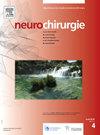New 3D printed simulator for training of endoscopic transsphenoidal surgery used in a dedicated pituitary course: A French cross-sectional study
IF 1.4
4区 医学
Q4 CLINICAL NEUROLOGY
引用次数: 0
Abstract
Context
The objective was to evaluate the feasibility and usefulness of a new 3D printed simulator for endoscopic pituitary surgery. This simulator was used at the Pituitary Workshop, a French theoretical and practical course designed to teach the basics of pituitary tumour management.
Methods
We conducted a cross-sectional study. The pituitary workshop had two components: (i) hands-on skills lab on the simulator, and (ii) lecture-based learning. The simulator was assessed by scoring its realism (face validity, score out of 80), its effectiveness in improving participants’ surgical technique (content validity, score out of 60), and its ability to differentiate levels of skill competence using performance metrics (construct validity, score out of 12). In a subgroup of 9 participants, the impact of the theoretical component of the course was also assessed (score out of 33), using a knowledge questionnaire before and after the course.
Results
Participants were neurosurgery residents (n = 24) and board-certified neurosurgeons (n = 6), supervised by expert neurosurgeons (n = 3). Face and content validity scores were high, reaching 63.3 ± 8.4 and 55.7 ± 4.6 respectively. Performance scores were higher in the group of experts and board-certified neurosurgeons than in the group of residents (12 ± 0 and 11.3 ± 1.2 vs. 9.2 ± 2.3, P = 0.019). The knowledge score improved significantly after the workshop (25.5 ± 4.8 vs. 10.9 ± 5.8, P = 7.1e-05).
Conclusions
Based on the face, content and construct validity scores, simulation training using the new model can be considered feasible and useful for neurosurgery residents. The pituitary workshop has a positive practical and theoretical impact on the majority of participants.
用于专门垂体课程的内窥镜经蝶窦手术培训的新3D打印模拟器:法国横断面研究。
背景:目的是评估一种新的3D打印模拟器用于垂体内窥镜手术的可行性和实用性。该模拟器用于垂体研讨会,这是一门旨在教授垂体肿瘤管理基础知识的法国理论和实践课程。方法:我们进行了横断面研究。垂体研讨会有两个组成部分:(i)在模拟器上的动手技能实验室,(ii)基于讲座的学习。通过对模拟器的真实性(面部效度,80分),提高参与者手术技术的有效性(内容效度,60分),以及使用性能指标区分技能能力水平的能力(结构效度,12分)来评估模拟器。在一个由9名参与者组成的小组中,也评估了课程理论部分的影响(得分为33分),在课程前后使用知识问卷。结果:参与者是神经外科住院医师(n = 24)和委员会认证的神经外科医生(n = 6),由专家神经外科医生(n = 3)监督。面孔效度和内容效度得分较高,分别达到63.3±8.4分和55.7±4.6分。专家组和执业神经外科医师组的表现得分高于住院医师组(12±0和11.3±1.2 vs 9.2±2.3,P = 0.019)。工作坊后知识得分显著提高(25.5±4.8 vs 10.9±5.8,P = 7.1e-05)。结论:基于面部、内容和结构效度评分,采用新模型进行模拟训练对神经外科住院医师是可行和有用的。垂体研讨会对大多数参与者产生了积极的实践和理论影响。
本文章由计算机程序翻译,如有差异,请以英文原文为准。
求助全文
约1分钟内获得全文
求助全文
来源期刊

Neurochirurgie
医学-临床神经学
CiteScore
2.70
自引率
6.20%
发文量
100
审稿时长
29 days
期刊介绍:
Neurochirurgie publishes articles on treatment, teaching and research, neurosurgery training and the professional aspects of our discipline, and also the history and progress of neurosurgery. It focuses on pathologies of the head, spine and central and peripheral nervous systems and their vascularization. All aspects of the specialty are dealt with: trauma, tumor, degenerative disease, infection, vascular pathology, and radiosurgery, and pediatrics. Transversal studies are also welcome: neuroanatomy, neurophysiology, neurology, neuropediatrics, psychiatry, neuropsychology, physical medicine and neurologic rehabilitation, neuro-anesthesia, neurologic intensive care, neuroradiology, functional exploration, neuropathology, neuro-ophthalmology, otoneurology, maxillofacial surgery, neuro-endocrinology and spine surgery. Technical and methodological aspects are also taken onboard: diagnostic and therapeutic techniques, methods for assessing results, epidemiology, surgical, interventional and radiological techniques, simulations and pathophysiological hypotheses, and educational tools. The editorial board may refuse submissions that fail to meet the journal''s aims and scope; such studies will not be peer-reviewed, and the editor in chief will promptly inform the corresponding author, so as not to delay submission to a more suitable journal.
With a view to attracting an international audience of both readers and writers, Neurochirurgie especially welcomes articles in English, and gives priority to original studies. Other kinds of article - reviews, case reports, technical notes and meta-analyses - are equally published.
Every year, a special edition is dedicated to the topic selected by the French Society of Neurosurgery for its annual report.
 求助内容:
求助内容: 应助结果提醒方式:
应助结果提醒方式:


